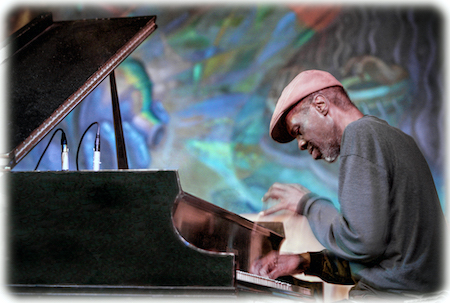Dec 9, 2025 12:28 PM
In Memoriam: Gordon Goodwin, 1954–2025
Gordon Goodwin, an award-winning saxophonist, pianist, bandleader, composer and arranger, died Dec. 8 in Los Angeles.…

Gayle (1939–2023) became a force in free-jazz after decades of indigence.
(Photo: Michael Jackson)Charles Gayle, a tenor and alto saxophonist who arose from long-term homelessness to become a key member of jazz’s avant-garde in the 1990s, died Sept. 5 in Brooklyn, New York. He was 84.
His death was confirmed by dancer and community organizer Patricia Nicholson Parker, who told National Public Radio that she had been notified by Gayle’s son Ekwambu. Cause of death was not specified; however, Gayle had for several years been afflicted with Alzheimer’s disease.
Frequently untethered to tonality or time, Gayle’s musical style is difficult to describe succinctly. His sound on the saxophone (he also played piano, bass and bass clarinet) was coarse and frequently shrieking, but he also favored short-note statements, could apply a remarkably soft voice to his shrieks and hid beneath that abrasive surface a melodic and rhythmic logic of his own that allowed his lines to unfold like poetry recitals. However, in a 2013 interview, Gayle told the Jazz Foundation of America that he was then “trying to play music that is more leaning towards what they call ‘regular jazz.’ I like time now more; I don’t want to leave it out now … and I want to try to really get in it more, inside.”
Gayle became a force in free-jazz only after decades of indigence. He spent the 1970s and ‘80s busking on the streets and in the subway stations of New York, living in a squat on Manhattan’s Lower East Side — apparently by choice. Gayle later said that, like Diogenes, he had consciously decided to shed his life of any material concern beyond playing and developing his music.
“Playing out there is obviously different than playing on a stage but that is so rich out there,” he told Cadence magazine. “I used to walk from Times Square, for instance, all the way to Wall Street playin’. I could walk back and never stop playing. I didn’t think about it as anything other than what it was.”
Charles Ennis Gayle Jr. was born Feb. 28, 1939, in Buffalo, New York. He rarely talked about his early life — history and identity were among the things he shed for his art. However, his father, Charles Sr., worked in steel manufacturing, while his mother, Frances, was a housewife. He also had a sister, Dorothy, two years his senior.
Gayle graduated from Hutchinson Central Technical High School in 1957 and, after a brief stint at Fredonia State Teachers College, began working as a musician in Buffalo. He made a recording in 1965 with bassist Buell Neidlinger and drummer John Bergamo (released 50 years later as Gayle Force.) After working as a music teacher at State University of New York–Buffalo, he moved to New York City in the early ’70s and promptly disappeared from the record.
“I had to shed my history, my life,” he said. “Everything had to stop right there.”
Gayle resurfaced in 1988. In April of that year he recorded three albums with bassist Sirone (Always Born, Spirits Before and Homeless) that put him on the jazz map. He toured Europe with bassist William Parker, and in 1991 recorded the seminal Touchin’ On Trane with Parker and drummer Rashied Ali. From there, Gayle built a formidable career in the avant-garde, working with Cecil Taylor, Sunny Murray, Parker and Ali. In 1996 his list of notable collaborators grew to include punk-rock icon Henry Rollins, who used Gayle and Ali on his album Everything. He became known for playing saxophone while wearing clownface makeup and a red nose. In the 2000s, he began recording acclaimed works for solo piano as well.
Gayle remained a singular force in the avant-garde well into the 2010s, but by mid-decade his output in both performance and recording had slowed considerably as Alzheimer’s slowly took its toll. His last recording was made in 2017; his last live performances were the following year.
Gayle is survived by his sons Ekwambu, Michael and Dwayne, as well as one granddaughter. DB

Goodwin was one of the most acclaimed, successful and influential jazz musicians of his generation.
Dec 9, 2025 12:28 PM
Gordon Goodwin, an award-winning saxophonist, pianist, bandleader, composer and arranger, died Dec. 8 in Los Angeles.…

Belá Fleck during an interview with Fredrika Whitfield on CNN.
Jan 13, 2026 2:09 PM
The fallout from the renaming of the John F. Kennedy Center for the Performing Arts to include President Donald…

Flea has returned to his first instrument — the trumpet — and assembled a dream band of jazz musicians to record a new album.
Dec 2, 2025 2:01 AM
After a nearly five-decade career as one of his generation’s defining rock bassists, Flea has returned to his first…

Dec 11, 2025 11:00 AM
DownBeat presents a complete list of the 4-, 4½- and 5-star albums from 2025 in one convenient package. It’s a great…

“It’s a pleasure and an honor to interpret the music of Oscar Peterson in his native city,” said Jim Doxas in regard to celebrating the Canadian legend. “He traveled the world, but never forgot Montreal.”
Nov 18, 2025 12:16 PM
In the pantheon of jazz luminaries, few shine as brightly, or swing as hard, as Oscar Peterson. A century ago, a…